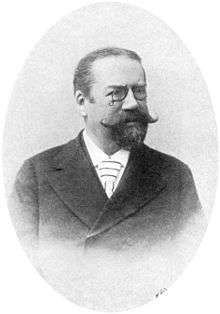Otto Michael Ludwig Leichtenstern

Otto Michael Ludwig Leichtenstern (October 14, 1845 – February 23, 1900) was a German internist born in Ingolstadt.
In 1869 he received his doctorate from the University of Munich, later working as an assistant of clinical medicine in Munich under Karl von Pfeufer (1806–1869) and Joseph von Lindwurm (1824–1874). After the death of Felix von Niemeyer (1820–1871), he served as interim head of the medical clinic in Tübingen prior to the appointment of Carl von Liebermeister (1833–1901) as Niemeyer's permanent replacement. Leichtenstern remained at the Tübingen clinic for several years, afterwards serving as head physician of internal medicine at the city hospital in Cologne (1879–1900).
Leichtenstern is remembered for publishing articles on almost every facet of medicine. In the field of helminthology, he made contributions in his investigations of hookworm (Ancylostoma duodenale).[1]
In 1898 he suspected that the compound 2-naphthylamine (2-NA) was involved in human bladder tumorigenesis. With Adolph Strümpell (1853–1925), the eponymous "Strümpell-Leichtenstern encephalitis" is named, a disease also known as acute hemorrhagic encephalitis.[2]
References
- Otto Michael Ludwig Leichtenstern at Who Named It
- Medscape.com Chemical Carcinogens—From Past to Present.
- ↑ Archive.org Full text of "Hookworm Disease: Proportion of Males to Females in the American Hookworm (Necator americanus), Based on 13,080 Worms from 102 Cases"
- ↑ Strümpell-Leichtenstern encephalitis @ Who Named It